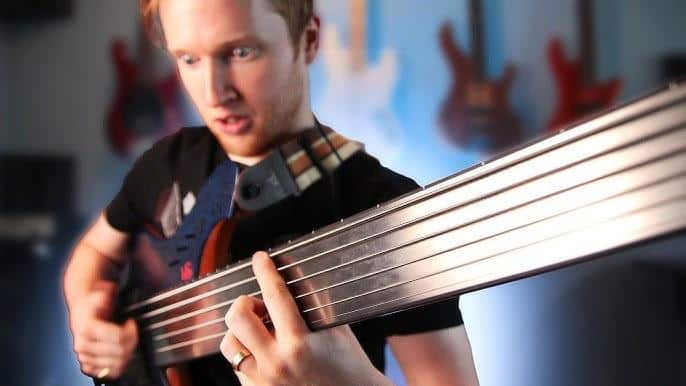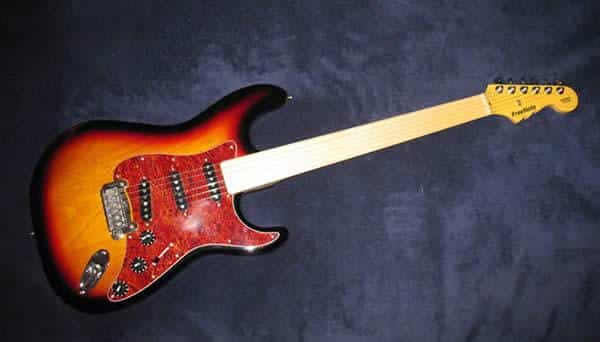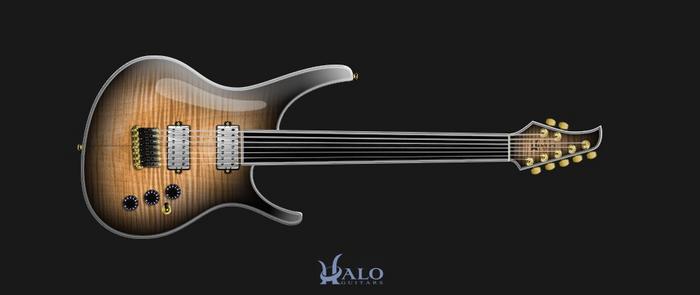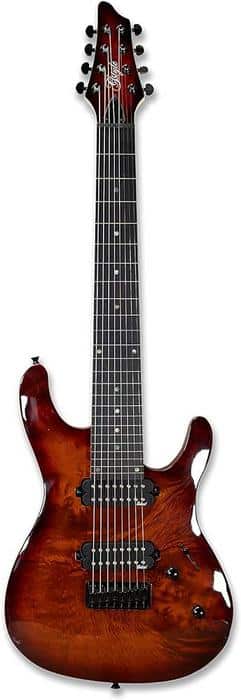Ever experienced a pivotal sound-altering encounter that left a stringed echo in your soul? My first meeting with a fretless electric guitar did just that, forever tuning my embrace of guitars to a tantalizing new frequency. But it wasn’t just any encounter; it was the kind where notes turned into seductive whispers, surely making any music aficionado lean in closer… sweeter, more versatile and mysterious than its fretted siblings.
As an experienced luthier and guitar enthusiast, my endless fascination with these incredible instruments is fueled by the nonpareil depth and diversity of sound they offer. My journey, which began in the humble year of 1994, has since become a dedication to unmasking the charm of the uniquely elusive fretless electric guitar.
Challenging the norms of tone and pitch, these guitars offer an auditory experience akin to nothing else, crying out to be discovered by those passionate about an untamed acoustic avenue. Stick around, and you’ll find a comprehensive guide that not only demystifies their sound but also provides practical advice on conversion and maintenance, along with informed reviews of popular models.
So, as we strum through the chapters of this guide, prepare yourself for an immersive journey into the world of fretless electric guitars. You’ll leave, I promise, with a newfound respect for these magnificent stringed marvels and an inevitable urge to strike your own chords on one.
Sound Characteristics of Fretless Electric Guitars
The Unique Sound of a Fretless Guitar

Moving on from a general overview of the sound characteristics of fretless electric guitars, let me delve deeper into the unique sound of these intriguing instruments. Much of my work has centered on the creation of these unique guitars, with each one bearing its own individual sonic signature. As a designer, balance is key for me; a fusion of cherished traditions and the possibilities availed by cutting-edge technology. The result is always a fascinating fretless guitar sound that impresses with its distinctness.
The uniqueness of the fretless guitar sound stems mainly from what’s absent; the frets. The moment these metal strips are removed from the neck of the guitar, it gives birth to a breakaway from the standard, predictable tonal outcome. With this ‘rebirth’, the fretless guitar fosters a sonic blend that harmoniously marries the predictability of melodies with the free-spirited nature of improvisation.
During my journey of crafting these instruments, one aspect that stood out is the sliding notes. This is an attribute that’s emblematic of fretless guitars. Without frets, the fingers are free to slide along the string, producing a fluid, legato note shift. The results are akin to a violin or a cello; a continuous, flowing sound absent of usual guitar percussiveness. It’s like comparing the languid grace of a river to the energetic cascade of a waterfall; different, but equally mesmerizing.
Listen closely and you’ll notice the microtonal effects, a trait exclusive to fretless guitars. The absence of frets allows a greater scope for nuance, providing a graver, heavier sound when the string is pressed against the fretboard. It is these nuances that play a huge part in creating the ethereal, otherworldly feel often associated with fretless guitar sounds.
In my designs, the interplay between fretless freedom and expressive sounds is the secret ingredient. And the fretless guitar sound isn’t confined to any one genre. Whether it’s jazz phrasings, the wail of the blues, the soulful strains of RnB, or burning rock riffs, the fretless guitar molds its tone to capture the essence of each style, augmenting and often elevating the narrative carried by the melody.
Understanding the unique sound of a fretless guitar not only broadens our understanding of this remarkable instrument but also helps us appreciate the emotional depth and versatility it adds to music. As we delve deeper into the world of the fretless in the following sections, remember, every note played, every chord strummed, and every slide is as unique as the guitar itself. The goal of balance I mentioned earlier starts sounding more like a symphony, doesn’t it?
Sustain and Intonation on a Fretless

As we delve further into the intriguing sound characteristics of fretless electric guitars, I pay special attention to two defining elements that significantly shape the guitar’s sonic identity: the sustain and intonation. The appeal of sustain on a fretless guitar and the exactness in intonation on a fretless guitar underscore the unique, expressive nature of these instruments.
Sustain, a phenomenon when a note continues to resonate after being played, and its ability to hold a pitch for an extended duration, is a distinct marker of fretless guitars. In my journey as a guitar designer, I have always prioritized ensuring the maximal sustain in the guitars I craft. The lack of frets lends to a smoother string vibration, free from any potential interference that can prematurely dampen the sound. I ensure the string contact with the fingerboard is mild yet secure, facilitating a longer, purer sustain than its fretted counterparts, thereby permitting a guitar player more space and freedom to create the desired musical panorama.
The other crucial aspect is intonation. On a fretted guitar, the frets dictate the pitch of every note, but on a fretless, the location of each note is in the hands of the artist. Precision in the intonation on a fretless guitar is fundamental to its unique voice. It affords the player an opportunity to strike notes located ‘between the frets’, thereby offering a broadened melodic palette colored with micro-tonal nuances.
This dual dynamic of sustain and precise intonation in my fretless models inspires players to explore new territorial sounds and modes of musical expression forbidden by the fretted boundaries. They also serve to enhance the depth and richness of the guitar’s tone, contributing to their appeal among many music artists.
As we move forward toward understanding how to convert a regular guitar to fretless, bear in mind, the outstanding sustain and precise intonation are the lures that enhance the player’s creative pallete. It’s this understanding of sound, and appreciation for the uniqueness and possibilities hidden within a fretless guitar, that truly delivers the desired harmonic outcome.
How to Convert a Regular Guitar to Fretless
Steps to Convert Your Guitar

In my decades of lutherie work, converting a guitar to a fretless one has always been an interesting process. Transforming a regular guitar to a fretless one requires a sense of patience, attention to detail, and precision, similar to sculpting a delicate piece of artwork. The process can be exhilarating, as you’re giving your instrument a unique voice, but it is also a commitment that should not be taken lightly. Let’s delve into the steps to convert your guitar to fretless and embark on this rewarding journey.
Firstly, the fret removal process begins. This can initially seem daunting, but with meticulous care, it can be done successfully. I employ a small flat head screwdriver or a specialized tool to gently pry the frets from the fretboard. Emphasizing here, the word ‘gently’ as the primary sentiment since you don’t want to cause excessive damage to the fretboard itself.
With the frets removed, you need to fill the fret slots. I typically use veneer – thin slices of wood – that matches my fingerboard material. Take the measurement of the fret slots so you cut the veneer accordingly. Again, precision is paramount in this step of fretless guitar conversion.
Once the veneer is installed, sanding is the next step. Through the years, I’ve learned that using a radius block helps in sanding the veneer flat and matching the fretboard’s curve. Here, patience and a keen eye for detail kick in again, ensuring you don’t mar the beautiful surface of your soon-to-be fretless guitar.
Once the fingerboard is perfectly smooth, we move ahead to finishing the fingerboard. Some luthiers, including myself, prefer to apply a coat of epoxy, which gives it a glass-like surface. This not only enhances the guitar’s sound but also gives it a more professional look. However, some players prefer the rawness of an uncoated fretless guitar fingerboard – yet another aspect that adds to the guitar’s unique personality.
As we are closing the section on steps to convert a guitar to fretless, I cannot stress enough the importance of setup after the conversion. Converting a guitar to a fretless instrument changes the action and intonation, making it crucial to devote time in setting up the guitar to match your playing style. Intonation setup becomes incredibly significant, and you need to ensure the guitar’s overall action and feel remain as comfortable as before.
Every guitar has its charm and personality. The voice of a fretless guitar is unique and can provide you with a new playing experience, broadening your musical horizons. It is not an easy task to convert a regular guitar to a fretless one, but it’s indeed a rewarding journey that imbues the instrument with a sound and character that only a fretless can deliver.
After highlighting the steps, let’s get into the finer details of maintaining a fretless guitar in our next section, to ensure our guitar remains in a pristine and playable condition for years to come.
Maintaining Fretless Guitar

Having covered the conversion process, let’s direct our attention to an equally significant aspect – the care and maintenance of your newly converted fretless guitar. This step is not to be taken lightly, as it significantly contributes towards preserving the unique tones and beauty of your instrument.
In my editorial work, I’ve constantly emphasized on the importance of fretless guitar care. It’s vital to regularly clean your strings after usage to prevent accumulation of oils and grime which could affect the sound quality. Choosing the right cleaning products is key as harsh chemicals can damage the fretboard. Hence, opt for nonabrasive guitar-friendly cleaning solutions.
Fretless guitar maintenance also involves caring for the neck and fretboard. Unlike fretted guitars, wear and tear can be more noticeable, hence the fretboard requires diligent conditioning and cleaning. Use oils designed for guitar necks to keep the wood moisturized and prevent dryness.
It might also be worth considering a professional setup for your fretless guitar. A professional luthier can examine your instrument, adjust the truss rod for optimal neck relief, and smooth any irregularity on your fretboard which might be affecting your playability.
Ultimately, maintaining your fretless guitar is essential not just for prolonging its lifespan, but also for its sound quality, playability and aesthetics. It is one investment that will pay off in the future, ensuring the longevity of your unique instrument for years to come.
Now that we’re versed with how to take care of our fretless guitar, let’s move on to understanding the various models available and where to buy them from, which are equally important in our comprehensive fretless guitar journey.
Selecting a Fretless Guitar: Models and Availability
Top Fretless Guitar Models

As you dive deeper into the world of fretless electric guitars, an integral part of your journey involves choosing a model that suits your style and preferences. Fretless guitar models are numerous, each with unique features and sounds. Having spent countless hours both crafting and playing these instruments, I’m in a good position to guide you in your quest for the perfect fretless.
Starting with one of my personal favorites, we have the renowned Vigier Surfreter. Known for its immaculate build and stunning tone, the Surfreter manages to not only meet but exceed the standards set by traditional fretless models. The guitar’s zero fret concept eschews conventional metal lines for a unique and innovative Phenowood fretboard. This innovative design imparts a warm, clean tone with a resonating sustain, making it a distinct choice for musicians looking for a touch of the extraordinary.
Another favorite, less mainstream but just as worthy of acknowledgment, is the series of Lava Drops guitars. Crafted right in the heart of Europe, Lava Drops are all about capturing the unique essence of each musician who wields them. With customizable options ranging from body wood to type of finish, each guitar is a unique testament to craftsmanship and personal expression. These guitars are not just aesthetically appealing, but they also package exemplary playability and versatile sound profiles. Lava Drops’ hollow body models especially produce a rich, vibrant tone, offering a whole new level of sonic textures to explore.
Though each model varies distinctly in features, what is consistent among top fretless guitar models is the unparalleled degree of vibrato, the smooth glissandos, and the potential for microtonal expression. This makes them an excellent choice for players seeking to push the boundaries of their musical voyages.
As you proceed in your pursuit, be open to trying out a variety of guitars and remember, the key is to find a fretless model that resonates with your musical instincts and preferences. The guitar may be fretless, but your journey in selecting the right one is absolutely not fruitless.
Now that we’ve covered some of my favorite models, let’s consider where to acquire your dream fretless guitar. Whether you’re aiming for a Vigier, a Lava Drops, or another model entirely, knowing your go-to sources can make your quest significantly easier.
Where to Buy Fretless Guitars

As we delve further into the realm of selecting the perfect fretless guitar, exploring models and availability, a crucial aspect that begs attention is understanding where to buy fretless guitars. With years of writing and researching different guitars in numerous lutherie journals, I can confidently say that finding the right seller can vastly enhance your process of purchasing a fretless guitar.
Fretless guitar shops with an online presence are treasure troves of assortment and convenience. From the comfort of your couch, you can explore numerous guitar models, compare prices, and often benefit from reviews left by previous customers. Major online retailers like Guitar Center, Sam Ash, and Sweetwater are excellent starting points. They offer a wide array of choices for new and used instruments, often with detailed specifications, images, and clips. Always look out for clear return policies and warranty details before committing to a purchase. Buying from these reputable sources can give you peace of mind about the legitimacy and quality of your purchase.
When you buy fretless guitar from an online platform, however, you forfeit the tactile experience of trying the guitar before purchasing. This is where brick-and-mortar fretless guitar shops gain merit. Fortunately, most towns and cities will have at least one, if not more, music shop that will potentially carry fretless guitars. You can strum, feel the weight, and assess the build quality directly. Furthermore, you can get hands-on guidance from the staff who are usually knowledgeable about the instruments they sell.
Whether you choose to buy online or in-store, I’d recommend trying to play the guitar in person before buying. If needed, you can always make an appointment at a local store to try out the fretless model you’ve liked online. Remember, buying a fretless guitar is a fascinating adventure that should ideally end with you finding an instrument that matches your unique sound and style.
In the next section, we will examine a few top fretless guitar models, guiding you on what to look for when choosing your instrument. Keep in mind our discussion on where to buy as we proceed – your quest for the perfect fretless guitar will largely depend on finding the right retailer, whether online or in-store.
FAQs
What is a fretless electric guitar?
What sound can you expect from fretless electric guitars?
How do you convert a fretted guitar into a fretless one?
Are there any notable fretless electric guitar reviews?
Conclusion
In our exploration of the fretless electric guitar, we’ve delved into its unique sound, the conversion process, and considered the best available models. This instrument is a treasure trove of opportunity for any devoted musician keen to experiment beyond the common constraints of fretted models. Its superior sustain and intonation, when executed with precision and practice, can enhance your musical virtuosity.
Are you ready to immerse yourself in the sonorous world of fretless electric guitars? Remember, understanding and mastering any musical instrument casts it in a new light, leading to a deeper appreciation for its intricate capabilities. Let the knowledge we’ve shared together on my journey into the world of fretless guitars guide you as you embark on your own.
Remember, converting a regular guitar requires a certain level of commitment and patience, but the fruits of your labor can be immensely rewarding. Maintaining your fretless electric guitar will ensure its longevity, enabling you to enjoy its unique resonance for years to come.
In conclusion, there is a world of exciting potential that is unlocked by diving into the world of fretless guitars. Embrace this journey as an opportunity to evolve as a musician, and as always, enjoy the ride!
